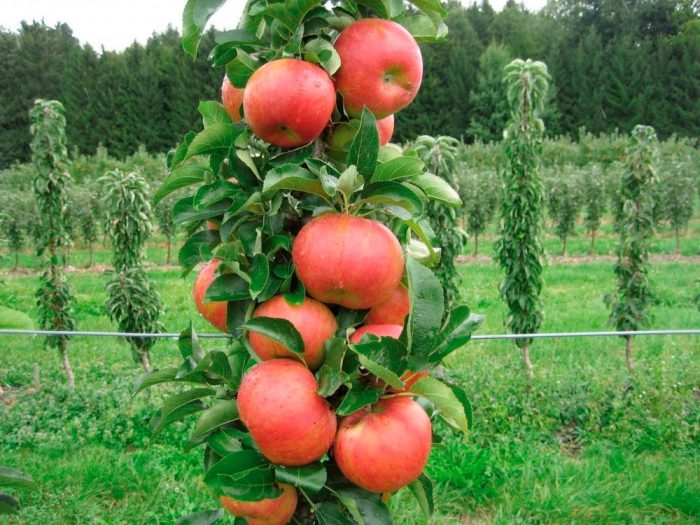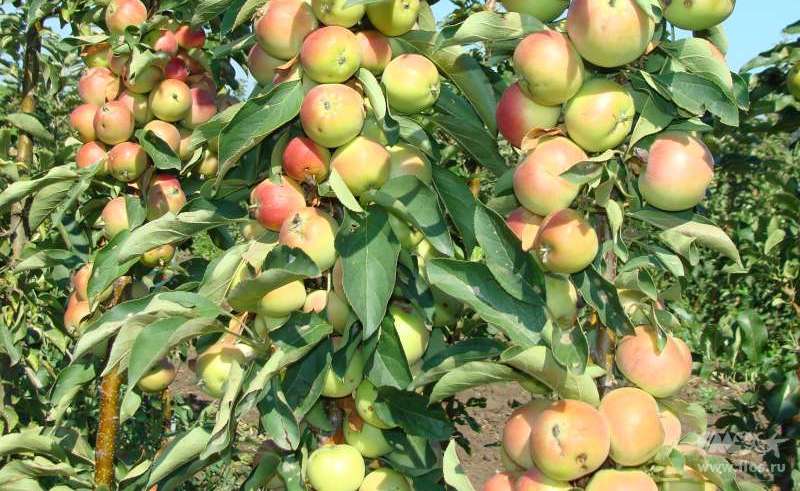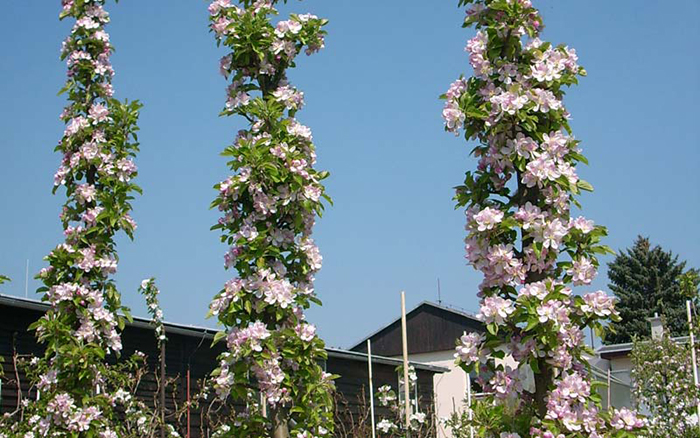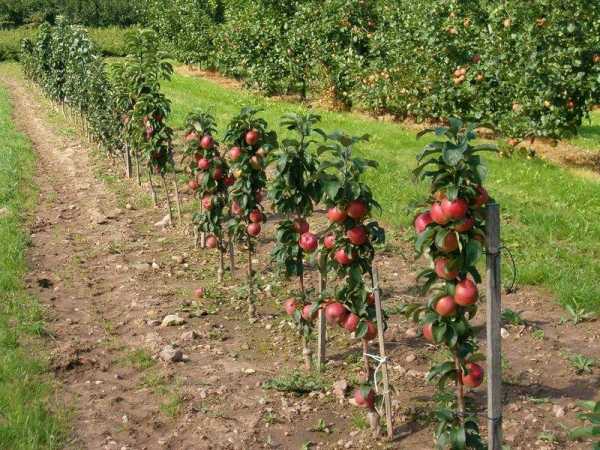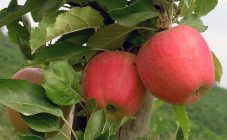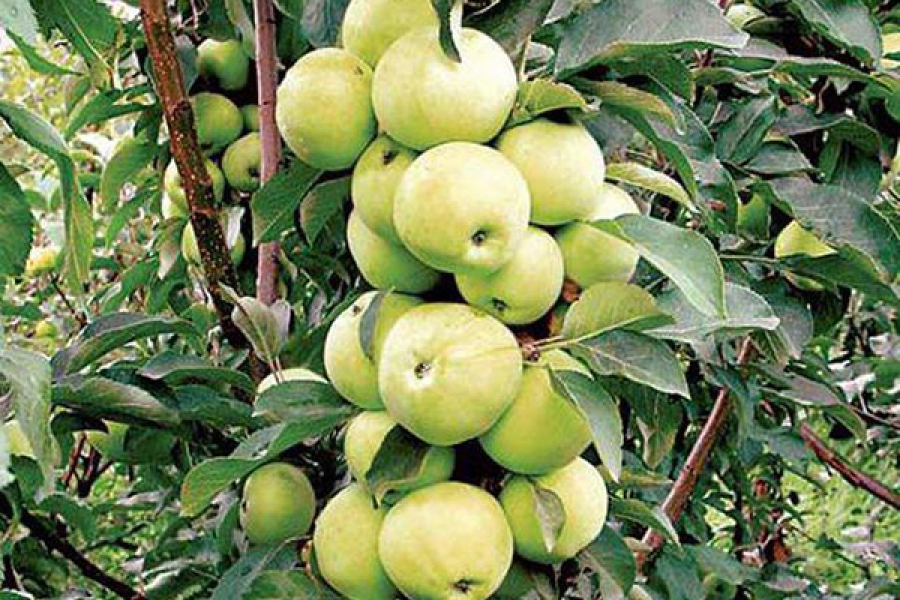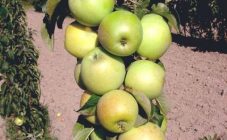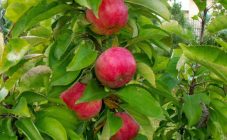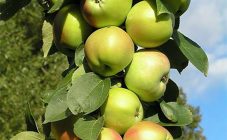Content:
Columnar apple trees are fruit and small trees. The height of the tree rarely reaches 2.5 m. Meanwhile, such a low-growing species is distinguished by good fertility. Some varieties give sweet apples as early as the second year after planting. As the name itself makes clear, the crown of the apple tree is not wide: the maximum is 0.5 m in diameter. The branches from the trunk are practically at an even angle. Due to the fact that they grow along the conductor, outwardly the tree becomes very similar to the pyramidal poplars.
The tree trunk itself is somewhat thickened. You can see that many small branches-branches depart from it. Flower buds are placed on the tops of the apple trees.
Depending on the stock, they are divided into:
- dwarf;
- subdwarf.
Most varieties of the species begin to bear fruit in 2-3 years. With each subsequent year, the harvest becomes richer. The peak of fruiting falls on the 6-8th year of the apple tree's life. Only if the care of the tree is correct, you can count on a long-term yield - up to 15-20 years.
The best varieties
Thinking about the question of which variety is better to choose for your garden, it is worth considering the fact that those fruit trees that can withstand at least 25 degrees of frost are suitable for Siberia. Given this priority indicator, we can point to some of the best columnar apple varieties for the region.
Apple-tree Barguzin columnar
This is the pride of Russian breeders. Refers to semi-dwarf autumn varieties. Apple tree Barguzin provides very good yield indicators - up to 25-35 kg. The tree is frost resistant and immune to many plant diseases. The fruit is sweet, with a slight sourness.
Apple tree Pedestal columnar
Growing Piedistal will be easy. It does not require virtually any pruning and is completely satisfied with the moisture obtained from rain and melted snow. The tree will have to be watered only during dry periods. Apple fruits are large (up to 160-220 grams) and have a sweet and sour taste.
Apple tree Cornet columnar
This is a self-fertile, winter-hardy variety of Russian selection. The fruits are red and oblong-round in shape. One apple can weigh 150-200 grams. The peel of the fruit is dense, the flesh is very juicy and aromatic.
Renet Mazherova
A variety of autumn ripening fruits. Ranetka (semi-culture) grows to a height of 2 m, the width of its crown can reach 40 cm. The fruits of the apple tree are rounded, bright yellow outside. The apple pulp is juicy, yellow. The fruits have a high tasting score for sweet and sour taste and special aroma.
Apple tree Malukh
The most unpretentious and aesthetic variety. It doesn't need pruning at all. Differs in low growth (up to 190 cm). The apple tree fruit is sweet, oval and red. The tree gives the first apples weighing 100-130 grams the next year after planting. Often used for landscaping.
Naming the best apple varieties specifically for Siberia, one cannot fail to mention the following: Conference, Sibirka, Sinara, Vasyuta, Iksha, Triumph, Dialogue, Medok, Jin, Ostankino.It is appropriate to use all the named apple trees for the Arkhangelsk region - the varieties are perfect for areas with cold winters and short summers.
The best choice for Siberia
How to choose a variety
As experienced farmers point out, not every columnar apple tree can provide a good harvest for Siberia. When choosing the best option, you should focus on: winter hardiness, taste, storage period of fruits.
Having analyzed various varieties of apple trees for Siberia, it should be noted that those that have at least a score of 4.5 in terms of frost resistance are most suitable. This means that the tree is able to withstand temperatures down to -25 ° C. Those that have a score of 5 are able to survive frost down to -50 ° C.
As a rule, the Siberian apple tree has a good keeping quality of apples. Fruits can be stored from August to October, some even to January. Preference should be given to the variety that is characterized by these best qualities.
New varieties of apple trees appear on the market every year, so experts advise experimenting with them, testing them in your garden.
Purchase of seedlings
A tree will grow well, the seedling of which was healthy and strong. When going shopping for your garden, it is better to follow these simple tips:
- The planting material must necessarily contain a tag. This indicates the age of the plant, its variety. In addition, the seller must have documentation with him (and, at the buyer's request, show it), which must indicate the fruiting period of the apple tree, information about how frost-resistant the seedling is, how resistant it is to diseases and parasites, etc.
- The nursery usually allows you to buy a seedling that has not yet been dug. It is better to give preference to a tree that has no visible damage. You need to carefully examine both the bark of the seedlings from all sides, and the roots themselves (if we are talking about the dug out).
- The roots should be firm with no bumps or bulges.
- It is better to give preference to "one-year-old" seedlings. Such should not have any branches. The trunk of the plant should be about 6-7 cm. The optimal number of buds is 5-6 pieces.
- If possible, it is better to buy seedlings with a closed root system. Experience has shown that these are stored longer and are more likely to be accepted.
- Plants with grafts should be examined especially carefully. A fragile rootstock can significantly harm the plant.
Timing and methods of planting
The best season to plant columnar apple varieties in Siberia is spring. Podzimnyaya (that is, autumn) planting threatens with freezing of seedlings.
With regard to the choice of methods and methods of planting, here also should take into account the harsh western climate. Some Siberian gardeners suggest planting a columnar apple tree using the method. In this case, the seedling is placed in the planting hole at an angle. In winter, this allows it to be bent to the ground and more reliably protected from frost.
If the climate in the region is milder, planting can be done in the usual way by placing the tree in a previously prepared hole.
You can also plant a columnar apple tree using the container method.
Landing technology and scheme
Most of all, the columnar apple tree (varieties for Siberia, like all other varieties of this species, are distinguished by a weak root system) loves moist and loose, fertile soils. The soil should be good for air and water. For planting a whole apple orchard, it is better to select areas with a high (from 2-3 m) groundwater table.To get a good harvest, you need to choose a sunny and well-sheltered area.
Due to the narrowness of the crowns, the columnar apple tree does not take up much space on the territory. Meanwhile, it must be planted at a distance of 40 cm from other trees.
It is better to prepare the planting pit in the fall. Its diameter depends on the size of the seedlings itself: all roots should be freely placed at the bottom of the pit. Even in the fall, several handfuls of humus or compost should be laid out at the bottom of the pit. You can replace these fertilizers with potassium-phosphorus fertilizers. For one planting hole, it is enough to use only 2 tablespoons of mineral dressing.
You can place a seedling in the soil when there is a stable above-zero temperature outside, both during the day and at night. Immediately before planting, the roots of the seedlings are placed in clean warm water for 10 hours. If the tree for planting was recently dug up, and its roots did not have time to dry, this will not have to be done.
An excessive amount of mineral fertilizers, as well as trauma to the roots or trunk during planting, can lead to the death of the apple tree.
Apple tree care
The tree requires most attention during the growing season. If it has enough moisture, then the fruits over time the tree will give juicy and tasty. Each tree should have 1-2 buckets of water. To prevent moisture from disappearing so quickly, the watering area can be sprinkled with dry grass. Watering frequency depends on the soil. If it dries up to a depth of at least 4-5 cm, then it needs a new portion of water.
The first feeding is carried out at the time of planting the tree: organic fertilizer or mineral fertilizer is added to the pit.
The second - a month after disembarkation. For this case, a urea solution (50 g per 10 l of water) is more suitable. Pouring is performed at the root.
The third and fourth feeding are performed at intervals of 2-3 weeks with the same solution.
Shaping and pruning a tree
The columnar apple tree is one that does not require frequent pruning. The main type remains sanitary pruning, that is, the removal of dried branches damaged by parasites or mechanical actions.
Since the frosty Siberian temperature threatens the tree with freezing of the top, it must be systematically shortened to the height of a stronger shoot. After icing some branches and cutting off the top, the apple tree is able to recover quickly enough. In the spring, replacing shoots grow, which bear fruit well.
If the circumcision is carried out carefully, then the apple tree will be able to delight its owners for longer than 20 years.
Preparing for winter
As Siberians point out, every frost-resistant apple variety can still freeze at too low temperatures. The apical kidneys remain the most vulnerable.
You can save a tree from such a nuisance if you cover it in advance. The ideal option for this purpose would be:
- sackcloth;
- spunbond.
Some other insulation materials will be useful in this regard, which provide the tree with normal air access, but also protect against sudden gusts of wind. The apple tree will survive the winter easier if, after each massive snowfall, the trunk and the root zone are covered with snow. Since the bark of the tree is very delicate, it should be tamped carefully.
Advantages and disadvantages
The description and recommendations of the farmers make it clear that, as a fruit tree, columnar apple trees (winter-hardy varieties for Siberia) have some advantages over other trees.So, the pluses include the fact that the plant has a very compact size. At first glance, it may seem at all that it consists only of the trunk. Meanwhile, the tree has a crown, the width of which is practically the same along its entire length.
These trees do not grow tall, which makes them easy to care for and easy to harvest.
This variety provides an early harvest - the first apple can be tasted already in the second year of the plant's life.
In addition, the plant has a high decorative value. The apple tree can be successfully planted along garden paths or used to create decorative compositions with low-growing shrubs.
As for the disadvantages of this variety of apple trees, these include:
- can lose its shape, which means an attractive appearance due to improper care;
- short-term fruiting and life - up to 15-20 years;
- the possibility of grafting only on dwarf trees;
- the need to fertilize the earth with microelements.
Summing up all of the above, we can conclude that in the harsh Siberian conditions it is possible to grow a garden of columnar apple trees. The process of planting and caring for plants will be slightly different from what takes place in the warmer southern parts, however, careful care and adherence to basic agricultural rules remain the main condition.
